
The necropolis of Draʻ Abu el-Naga' is located on the West Bank of the Nile at Thebes, Egypt, just by the entrance of the dry bay that leads up to Deir el-Bahari and north of the necropolis of el-Assasif. The necropolis is located near the Valley of the Kings.

The necropolis of El-Khokha is located on the west bank of the river Nile at Thebes, Egypt. The necropolis is surrounds a hill and has five Old Kingdom tombs and over 50 tombs from the 18th, 19th and 20th dynasties as well as some from the First Intermediate Period and the Late Period.
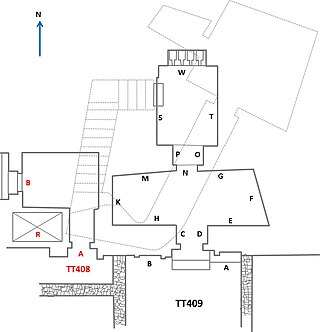
The Theban Tomb TT409 is located in El-Assasif, part of the Theban Necropolis, on the west bank of the Nile, opposite to Luxor. It is the burial place of the ancient Egyptian Samut called Kyky, who was Accountant of Cattle of the Amun domain, during the reign of Ramesses II during the Nineteenth Dynasty.

The High Priest of Amun or First Prophet of Amun was the highest-ranking priest in the priesthood of the ancient Egyptian god Amun. The first high priests of Amun appear in the New Kingdom of Egypt, at the beginning of the Eighteenth Dynasty.
Puimre, also spelled Puyemrê, was an ancient Egyptian noble, architect and Second Priest of Amun during the reign of Thutmose III of the 18th Dynasty of Egypt. He was the son of Puia and Lady Nefer-iah, and had two wives: Tanefert and Sensonb. His wife Sensonb was the daughter of Puimre's superior, the High Priest of Amun Hapuseneb and his wife Amenhotep. Sensonb served in the temple of Amun as a Divine Adoratrice.

The Theban Tomb TT31 is located in Sheikh Abd el-Qurna, part of the Theban Necropolis, on the west bank of the Nile, opposite to Luxor. It is the burial place of the ancient Egyptian official, Khonsu, who was First Prophet of Menkheperre, during the 19th Dynasty or 20th Dynasty.

Bakenkhonsu was a High Priest of Amun in ancient Egypt during the reign of Pharaoh Ramesses II. Information about his life was found on the back of his block statue. The information on the statue provides details about the education of young Egyptian noblemen at that time and the career of priests.
Nebwenenef was High Priest of Amun at the beginning of the reign of Ramesses II during the 19th Dynasty. Prior to that, Nebwenenef had served as High Priest of Anhur and High Priest of Hathor during the reign of Seti I and possibly even earlier.
Amethu called Ahmose was a vizier of ancient Egypt. He served during the reign of Thutmose II and the early years of the reign of Hatshepsut and Thutmose III of the 18th Dynasty.

The Theban Tomb TT35 is located in Dra' Abu el-Naga', part of the Theban Necropolis, on the west bank of the Nile, opposite to Luxor. It is the burial place of the ancient Egyptian noble named Bakenkhonsu, who lived during the 19th Dynasty, during the reign of Seti I and Ramesses II. Bakenkhonsu, Bakenkhons, or Bekenkhons was a High Priest of Amun. His Tomb was excaveted by the Expedition of the Museum of the University of Pennsylvania in 1921–1923.
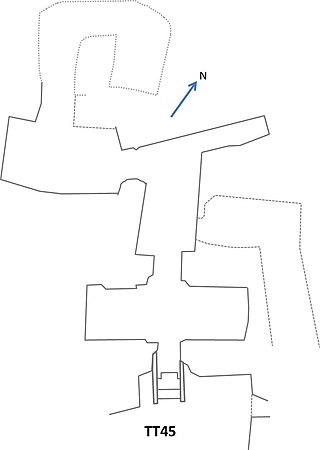
The Theban Tomb TT45 is located in Sheikh Abd el-Qurna, part of the Theban Necropolis, on the west bank of the Nile, opposite modern Luxor. It was originally the burial place of the ancient Egyptian named Djehuty (Thoth), who was a scribe of the offering-table of Mery, high-priest of Amun, head of all the weavers of Amun, and steward of Mery, high priest of Amun. Djehuty lived during the reign of Amenhotep II. He was the son of a lady also named Djehuty.

The Theban Tomb TT111 is located in Sheikh Abd el-Qurna, part of the Theban Necropolis, on the west bank of the Nile, opposite to Luxor. The tomb belongs to a 19th Dynasty ancient Egyptian named Amenwahsu, who was a Scribe of divine writing of the estate of Amun during the reign of Ramesses II. Amenwahsu was a son of Simut, who was a head of outline draughtsmen, and the lady Wiay. Amenwhasu's wife was named Iuy. She was a songstress of Bubastis.
Pennesuttawy was a Military Commander and Superintendent of the Southern Lands (Kush) during the beginning of the Nineteenth Dynasty of Egypt.
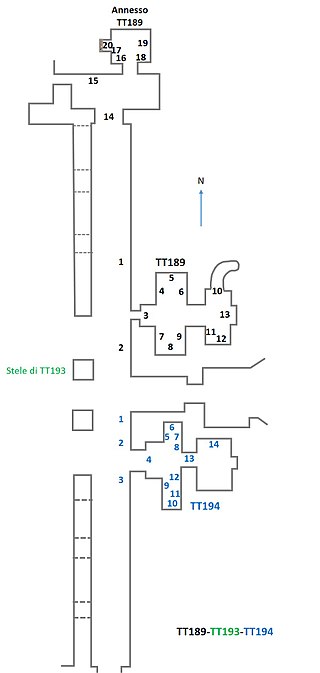
Tomb TT189 is located in the necropolis of El-Assasif in Thebes, Egypt. It contains the sepulchre of Nakhtdjehuty, who was an overseer of the carpenters of the northern lake of the god Amun and the head of the goldworkers in the Estate of Amun during the 19th Dynasty reign of Ramesses II. Nakhtdjehuty's tomb is part of the TT192 tomb complex.

The Theban Tomb TT178 is located in El-Khokha, part of the Theban Necropolis, on the west bank of the Nile, opposite to Luxor.
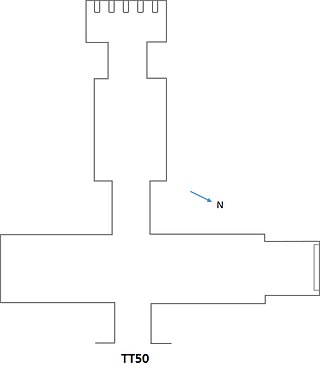
The Theban Tomb TT50 is located in Sheikh Abd el-Qurna, part of the Theban Necropolis, on the west bank of the Nile, opposite to Luxor. It is the burial place of the ancient Egyptian official Neferhotep, who was a Divine father of Amun-re during the reign of Horemheb of the 18th Dynasty.

The Theban Tomb TT214 is located in Deir el-Medina, part of the Theban Necropolis, on the west bank of the Nile, opposite to Luxor.

Mentuemhat or Montuemhat was a rich and powerful Theban official from ancient Egypt who lived during the Twenty-fifth Dynasty of Egypt and Twenty-sixth Dynasty of Egypt. He was the Fourth Priest of Amun in Thebes.

The Theban Tomb TT385 is located in Sheikh Abd el-Qurna, part of the Theban Necropolis, on the west bank of the Nile, opposite Luxor. It is the burial place of the ancient Egyptian Hunefer (Haunefer), who was a Mayor of the Southern City (Thebes) during the reign of Ramesses II in the Nineteenth Dynasty.
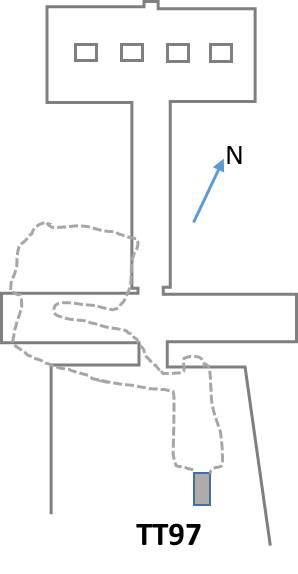
The Theban Tomb TT97 is located in Sheikh Abd el-Qurna, part of the Theban Necropolis, on the west bank of the Nile, opposite to Luxor. The tomb belongs to an ancient Egyptian named Amenemhat, who was the High Priest of Amun at Karnak, during the reign of pharaoh Amenhotep II of the 18th Dynasty. Amenemhat was the son of the wab-priest and "Overseer of the sandal makers of Amun", Djehutyhotep.
















